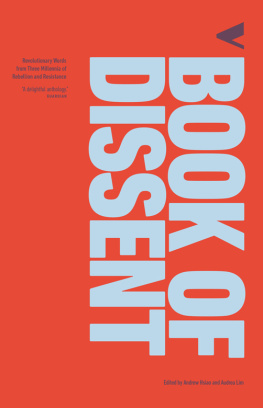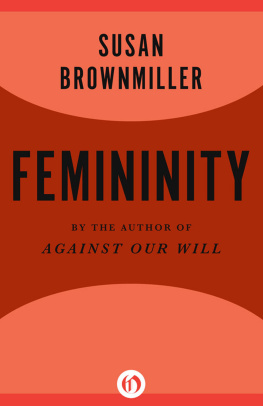ROUTLEDGE LIBRARY EDITIONS: POLITICAL PROTEST
Volume 8
FEMININITY IN DISSENT
FEMININITY IN DISSENT
ALISON YOUNG
First published in 1990 by Routledge
This edition first published in 2022
by Routledge
2 Park Square, Milton Park, Abingdon, Oxon OX14 4RN
and by Routledge
605 Third Avenue, New York, NY 10158
Routledge is an imprint of the Taylor & Francis Group, an informa business
1990 Alison Young
All rights reserved. No part of this book may be reprinted or reproduced or utilised in any form or by any electronic, mechanical, or other means, now known or hereafter invented, including photocopying and recording, or in any information storage or retrieval system, without permission in writing from the publishers.
Trademark notice: Product or corporate names may be trademarks or registered trademarks, and are used only for identification and explanation without intent to infringe.
British Library Cataloguing in Publication Data
A catalogue record for this book is available from the British Library
ISBN: 978-1-03-203038-8 (Set)
ISBN: 978-1-00-319086-8 (Set) (ebk)
ISBN: 978-1-03-200988-9 (Volume 8) (hbk)
ISBN: 978-1-03-200992-6 (Volume 8) (pbk)
ISBN: 978-1-00-317664-0 (Volume 8) (ebk)
DOI: 10.4324/9781003176640
Publishers Note
The publisher has gone to great lengths to ensure the quality of this reprint but points out that some imperfections in the original copies may be apparent.
Disclaimer
The publisher has made every effort to trace copyright holders and would welcome correspondence from those they have been unable to trace.
FEMININITY IN DISSENT
ALISON YOUNG
First published 1990
by Routledge
11 New Fetter Lane, London EC4P 4EE
Simultaneously published in the USA and Canada
by Routledge
a division of Routledge, Chapman and Hall, Inc.
29 West 35th Street, New York, NY 10001
1990 Alison Young
Typeset by Laserscript Limited, Mitcham, Surrey
Printed and bound in Great Britain by
Biddies Ltd, Guildford and Kings Lynn
All rights reserved. No part of this book may be reprinted or reproduced or utilized in any form or by any electronic, mechanical, or other means, now known or hereafter invented, including photocopying and recording, or in any information storage or retrieval system, without permission in writing from the publishers.
British Library Cataloguing in Publication Data
Young, Alison, 1962-
Femininity in dissent
Women portrayal by mass media
I. Title
305.4
Library of Congress Cataloguing in Publication Data
Young, Alison, 1962-
Femininity in dissent / Alison Young.
p. cm. - (Sociology of law and crime)
Includes bibliographical references.
1. Women in the press-Great Britain. 2. Antinuclear movement-Great Britain. 3. Women and peace. 4. Government, Resistance to-Great Britain. I. Title. II. Series.
PN5124.W58Y6 1990
302.23220941-dc20
89-77034
CIP
ISBN 0-415-04788-9
ISBN 0-415-04789-7 (pbk)
Critique does not have to be the premise of a deduction which concludes: this then is what needs to be done. It should be an investment for those who fight, those who refuse and resist what is. Its use should be in processes of conflict and confrontation, essays in refusal.
(Foucault, 1981:13)
The (political) economy of the masculine and of the feminine is organised by different requirements and constraints, which, when socialized and metaphorized, produce signs, relationships of power, relationships of production and reproduction, an entire immense system of cultural inscription readable as masculine and feminine.
(Cixous, 1986: 80-81)
Well face them with refusals
Well face them with song.
Well blockade their bases,
Sit silent and strong.
We dont want their missiles,
We dont want their wars.
So well stay here at Greenham,
Well stay here at Greenham,
We wont move from Greenham
Till peace it is ours.
Well, have you seen pictures
Of bodies all burned?
Imagine if you and your familys
So hurt.
We can stop their madness,
But we must do it NOW.
So come down to Greenham,
Take a fence down at Greenham,
We wont move from Greenham,
For times running out.
(Rebecca Johnson and other Greenham women, 1987)
CONTENTS
Preface
2 THE WRITING OF BODIES: GREENHAM COMMON AS POLITICAL PROTEST
3 DRAMATIS FEMINAE: THE FEMALE BODY AT GREENHAM COMMON
4 THE METAPHORICAL THREAT
5 GREENHAM COMMON AS NEWS NARRATIVE
6 POLITICS AND THE NEWS DISCOURSE: AN INSTITUTIONAL SCAFFOLD
7 THE TIME OF A CONCLUSION
Appendix: On methodology: discourse, feminism, representation
Notes
Bibliography
Within criminology and the sociology of deviance, a major field of inquiry concerns the development of categories for the description of behaviour or ideology as wrong, abnormal or deviant. One way of examining the constitution of such definitions is to analyse their incorporation into discourse. In this book my interest has been to look at the discourse constructed by the national press around a particular form of deviance, an anti-nuclear protest by women at the Greenham Common missile base. Questions of normality and deviance within the press coverage pivot around conceptions of femininity, the maternal, the family, violence and the liberal democratic state. My concern has been to read the influence of these structures within the news reports and to discern the specificity of that influence in relation to the Greenham Common protesters.
I believe that the discourse of the press is an important subject for analysis in the inquiry into the construction of definitions of deviance and their representation because of its pervasive, non-specialist and everyday nature. The reading of a newspaper is an accepted part of the daily rituals of millions. A concern with the content and structuring of the information produced and sold as news inevitably involves a recognition of the vastness of the audience who consume this discourse. In this project, the knowledge of the unequal relationship between producer and consumer of news (an ever-growing number of readers dependent on a shrinking group of news institutions) was a spur of conviction as to the projects necessity.
The politically disturbing question of media power is one of the main themes or impetuses behind this work: the other is the question of sexual difference and its representation. To a great extent, a focus on this question was implied by an interest in the construction of deviance and abnormality. Sexual difference is one of the key ways in which the normal is marked out from the deviant. This was glaringly obvious within the press reports. This book recounts the mechanisms through which this differentiation is constituted. It is intended for curious students, teachers and, especially, for others. The book was written within an academic context, but this should not be taken to mean that it is not a political text. Although divorced from issues of programmatic politics, every moment bound up in its production has been political, in that it seeks to ask (the often ignored) questions about the construction of categories. It is therefore irrevocably and unashamedly political.















